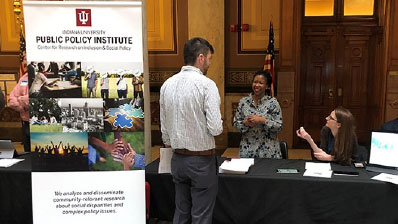by Leslie Wells, Assistant Director of Communications, the O’Neill School of Public and Environmental Affairs at IUPUI
It’s a data-driven world, and finding a partner to help in the process is critical to a nonprofit’s future, its funders and, most importantly, to those whom the organization serves. Most nonprofits want and need to be able to show promising results to justify their existing efforts and their plans for future expansion. At the same time, staff members at those organizations also want to know that their hard work is making a difference. Having solid, reliable data can help them accomplish both of these goals.
But data can be intimidating, and many groups don’t know where to begin.
“Any nonprofit needs to start with solid questions and ideas about what they’ll do and who they’ll serve,” said Breanca Merritt, director for the Indiana University Public Policy Institute’s Center for Research on Inclusion and Social Policy (CRISP). “Data helps you answer those questions and make informed decisions.”
CRISP recently partnered with the Martin Luther King Community Center in Indianapolis to address community crime prevention, thanks to a grant from the Central Indiana Community Foundation.
After reviewing the research CRISP conducted, leaders at the MLK Center assessed their strategy and shifted their focus to young people. They used the data CRISP collected to secure a grant and create the Best Buy Teen Tech Center. From computers to a recording studio and a 3D printer, the new space gives at-risk preteens and teens the opportunity to explore tech-based interests, careers, and opportunities.
Merritt says the MLK Center project is an example of what embracing data can do for nonprofits — and she has advice for organizations that are just beginning their data journey:
1. Define your vision. Decide who it is you want to serve and how, then think about what data or other resources you already have — or don’t have — to communicate that story.
2. Find a data and research partner. If you’re not a data person, find someone who is. Let them analyze your data before you reach your own conclusions. They can help you translate your big picture goals into something more tangible and measurable.
A good data and research partner organization should:
- Value your organization’s work
- Be knowledgeable about what you do
- Have a heart for your work, but the brain and expertise for the research you need
- Be adaptive, flexible, and patient
3. Don’t forget funders. Use data to give funders a more comprehensive picture of what you’re doing, why they should invest, and the return on their investment.
4. Review the data often. Ongoing evaluation allows you to make course corrections and stay on track. Merritt recommends reviewing the data at the six-month or one-year mark — and beyond.
“The six-month mark is a very forgiving review time because if something isn’t going according to plan, you have time to fix it,” she said. “But long-term evaluation matters, too. You don’t want to get 10 years into a program and realize you need to make major changes.”
Also, Merritt advised, reviewing data earlier on might be even more useful than waiting until the one-year mark, depending on the length of your program.
The CRISP Clinic
Even with this advice, many organizations often lack the staffing, time, and/or expertise to conduct even small assessments of internal data, client experiences or community engagement.
That’s where Merritt and her team can help. Beginning in spring 2021, the CRISP Clinic will begin accepting new organizations. The clinic will provide low- to no-cost research and evaluation services to help nonprofit organizations in Central Indiana that serve diverse populations and address issues of equity and/or social policy. The hope is to expand the services to other regions.
At the heart of the clinic is a diverse team of service-minded student researchers who can put their critical-thinking and evaluative skills to work for nonprofits in need. The student researchers will be overseen by Roxy Lawrence, a program analyst at CRISP. Initially, the clinic’s projects will likely be relatively small in scope, ranging from support in program development and capacity building, to client participation and engagement. The team will seek to understand how effective programs are, and the level of stakeholder and/or community engagement.
“These students have been instrumental in identifying, interviewing, and surveying the philanthropic organizations from which many local nonprofits receive funding,” Merritt said. “They’ve helped develop an application for organizations, a rubric for scoring those applications, and a schedule for onboarding and managing the clinic’s projects.”
Organizations will be selected based on three primary selection criteria:
Does the organization or program aim to achieve equitable outcomes among participants, service goals, or other aspects of the work?
Does the organization or program address issues of social policy?
Would the organization not be able to obtain these services elsewhere at low or no cost?
The team also will take into consideration other factors, including whether an organization could conduct any research-related activities on its own, the demographics of the clients served, the size and need of any related work, and the organization’s willingness to work with students.
These projects would last no more than three to four months each, from the initial identification and meeting with stakeholders, through development and implementation of research strategy, and the culmination in a final report.
Organizations that are interested in applying for the CRISP Clinic can reach out directly to Lawrence and Merritt at IUCRISP@iu.edu.

Leslie Wells


